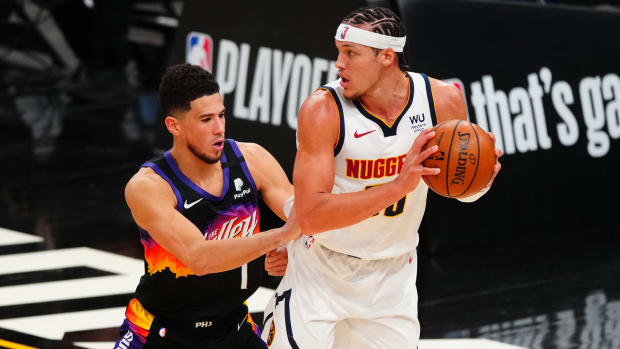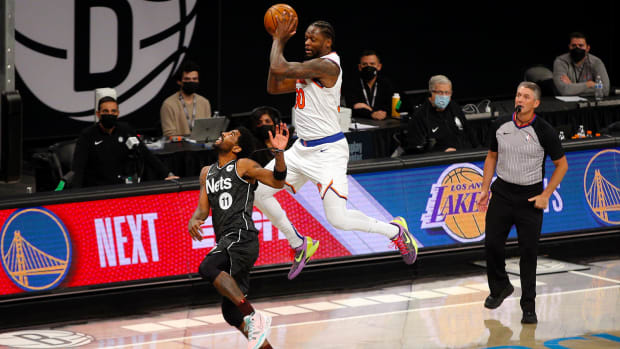100. Jordan Clarkson, Utah Jazz
(Previous rank: NR)
The NBA’s reigning Sixth Man of the Year is coming off a superb year where he averaged 18.4 points while leading the league in bench scoring. Clarkson’s production as a reserve played a big role in the Jazz earning the No. 1 seed in the West last season. He will be a key to Utah's title hopes again this season. — Wilton Jackson
99. Ivica Zubac, Los Angeles Clippers
(Previous rank: NR)
Outside of a three-point shot, Zubac checks every box necessary for a modern big. On offense, he's an expert offensive rebounder and a sturdy screener with soft hands as a roll man. On defense, he's smart as a rotating big and he won’t get bullied by the game’s biggest behemoths. Zubac is perhaps the least flashy player on our Top 100 list, but don’t let that detract from his value in Los Angeles. — Michael Shapiro
98. Larry Nance Jr., Portland Trail Blazers
(Previous rank: NR)
Sturdy forwards with quick hands, springy knees, shifty feet and the understanding of how to apply those physical traits into any defensive system are highly coveted throughout the NBA. Nance Jr. succeeded on that front with the Cavaliers last season. This season, the Blazers will appreciate him as much as, or more than, his former team did. — Michael Pina
97. Tyrese Haliburton, Sacramento Kings
(Previous rank: NR)
Haliburton’s rookie season deserved far more love than it received. His shot charts are impressive, even from the tougher areas. He shot well above 40% from the two midrange parts of the floor. The next progression in his game will be to make it to the line a bit more often, something that would make Haliburton—a 40.9% three-point shooter with a 3:1 assist-to-turnover ratio—even more efficient than he already is. — Chris Herring
96. Tim Hardaway Jr., Dallas Mavericks
(Previous rank: NR)
In his third season with the Mavs, Hardaway boasted his highest field goal percentage (.447), two-point percentage (.524) and points per game (16.6) in the 2020-21 campaign. He also notched the second-highest three-point percentage of his career. The Mavs will be looking for more from Hardaway after rewarding him with a four-year, $74 million contract this offseason. — WJ
95. Jonathan Isaac, Orlando Magic
(Previous rank: NR)
A torn left ACL and meniscus in August 2020caused Isaac to miss last season, but when available, he’s one of the league’s most disruptive defenders—able to alter shots, guard multiple positions and offer schematic versatility at 6' 11". The Magic hope a healthy Isaac will continue evolving as a scorer, with the size to shoot over defenders and skill to operate in different spots. His progress remains a key factor in Orlando’s rebuild. — Jeremy Woo
94. Malik Beasley, Minnesota Timberwolves
(Previous rank: NR)
Beasley leapt to 19.6 points per game in his fifth NBA season last year, showcasing an impressive scoring knack in Minnesota’s young core. He buried 39.9% of threes as his attempts nearly doubled compared to 2019-20, and he continues to be a dynamic athlete with a quick first step. Beasley’s explosion as a driver is critical in Minnesota. — MS
93. Derrick White, San Antonio Spurs
(Previous rank: NR)
White can do a little bit of everything and is dependable across the board, but drawing charges is the only skill he really excels at. Still, floor-raising production is always welcome, especially when it comes off a season when the subject’s three-point rate more than doubled from what it was two years ago. For now, White can make San Antonio’s rebuild less bumpy than it’d otherwise be, though his all-around trustworthy play could be even better used in a more competitive situation. — MP
92. Norman Powell, Portland Trail Blazers
(Previous rank: NR)
After developing into an integral part of Toronto's rotation, Powell was dealt to Portland mid-season last March. The 27-year-old versatile wing averaged 17 points in a career-high 34.4 minutes per game in 27 appearances with the Trail Blazers. How Portland's backcourt looks in upcoming seasons is certainly among the biggest questions in the NBA, but considering Powell inked a five-year, $90 million deal this offseason, he would figure to play a sizable role in their rotation. — BP
91. Evan Fournier, New York Knicks
(Previous rank: NR)
Fournier averaged 17.1 points on 41.3% shooting for three last season in stints with the Magic and Celtics. Despite his offensive prowess, the 28-year-old guard was hunted by the Nets on defense in the postseason. Now with the Knicks, Fournier will look to have his slashing ability mesh with Kemba Walker, R.J. Barrett, Julius Randle and Derrick Rose and help New York reach its second straight postseason for the first time since the early 2010s. — BP
90. Jae Crowder, Phoenix Suns
(Previous rank: NR)
Every NBA team needs a player like Crowder—a veteran leader and defensive anchor who handles the small hustle plays that don’t always show up in the stat sheet to help teams win. Heading into his second season with the Suns, Crowder still has a lot to offer to a young team looking to get back to the Finals. — WJ
89. Derrick Rose, New York Knicks
(Previous rank: NR)
Rose has reinvented himself as one of the league’s top reserves, providing a guiding hand and crafty scoring for a surprising Knicks team. While no longer lightning-quick, he’s one of the NBA’s top midrange scorers with his deep bag of runners and skillful finishing moves having endured. The 32-year-old Rose is also a legit catch-and-shoot threat, making a career-best 38% from three last season. Injuries scuttled his prime, but his resurgence as an elite role player has been remarkable. — JW
88. Andrew Wiggins, Golden State Warriors
(Previous rank: NR)
Wiggins will never live up to the expectations of the No. 1 pick, but he continued to grow as an effective two-way wing with Golden State in 2020-21. Last season marked the most engaged defensive season of Wiggins’s career, and he paired his defensive excellence with a solid 48% from the field and 38% from three. While he isn’t exactly a perfect fit for the Warriors’ pristine ball movement, he’s become less of a black hole in the Bay Area, too. — MS
87. Jaren Jackson Jr., Memphis Grizzlies
(Previous year rank: 64)
Jackson Jr. played in just 11 games for the Grizzlies last season after rehabbing a torn meniscus in his left knee and appeared to never get his shooting legs under him. He connected on a career-low 28.3% of his three-point looks, down from 39.4% the year before. Still, when healthy, Jackson Jr. remains one of the league’s most promising young bigs and an ideal pick-and-roll partner with Ja Morant. He’s shown flashes of star potential throughout his career, and at just 22 years old, he seems due for a breakout year sooner than later. — BP
86. Jonas Valančiūnas, New Orleans Pelicans
(Previous year rank: 97)
The Pelicans big man might be the most punishing rebound force in the NBA. He’s coming off a career year in Memphis, where he made defenses pay for sliding over to stop Ja Morant by immediately tipping home the acrobatic guard’s short-range misses. The fit next to Williamson—good or bad—will go a long way toward determining how New Orleans does this season. — CH
85. Duncan Robinson, Miami Heat
(Previous year rank: 99)
Robinson’s mark from three dipped to 40.8% last season from a 44.6% mark in 2019-20, but the undrafted forward remains a key cog in Miami’s attack. Robinson is a technician as he curls into wing triples or fades into the corner. He’s becoming increasingly crafty when crowded by defenders, creating space with a single hard dribble. Robinson is a perfect complement to Jimmy Butler and Bam Adebayo’s work inside the arc. —MS
84. Dillon Brooks, Memphis Grizzlies
(Previous rank: NR)
You’d be hard pressed to find someone who battles harder on defense than Brooks. For all the dividends that pays, though, it also has its drawbacks. Brooks logged five fouls or more a league-high 21 times last season. (The next closest guard or forward in the NBA did that just 13 times.) The next step in his progression is to have fewer wild swings from one game to the next. He’s too talented to be this inconsistent still. — CH
83. Jarrett Allen, Cleveland Cavaliers
(Previous rank: NR)
It will be interesting to see how Allen, one of the game’s premier two-way centers, fits into Cleveland’s crowded frontcourt rotation this season. But Allen will presumably play a big role for the Cavaliers, considering they doled out a five-year, $100 million deal to him this offseason. Last year, Allen averaged career-highs in points (12.8 per game) and rebounds (10 per game) after coming over from the Nets and was among the league-leaders in field goal percentage and blocks as well. — BP
82: Brook Lopez, Milwaukee Bucks
(Previous year rank: 72)
By now, Milwaukee knows precisely what to expect out of Lopez each year: 12 points, about five boards, and a block or two per game, on a three-point percentage that ranges from the low-to-mid 30s. Between that and what he does as the anchor in Milwaukee’s drop coverage, it’s the stuff of champions. So was his incredible 33-point showing versus Atlanta in Game 5 of the conference finals, without an injured Giannis. —CH
Last edited:

